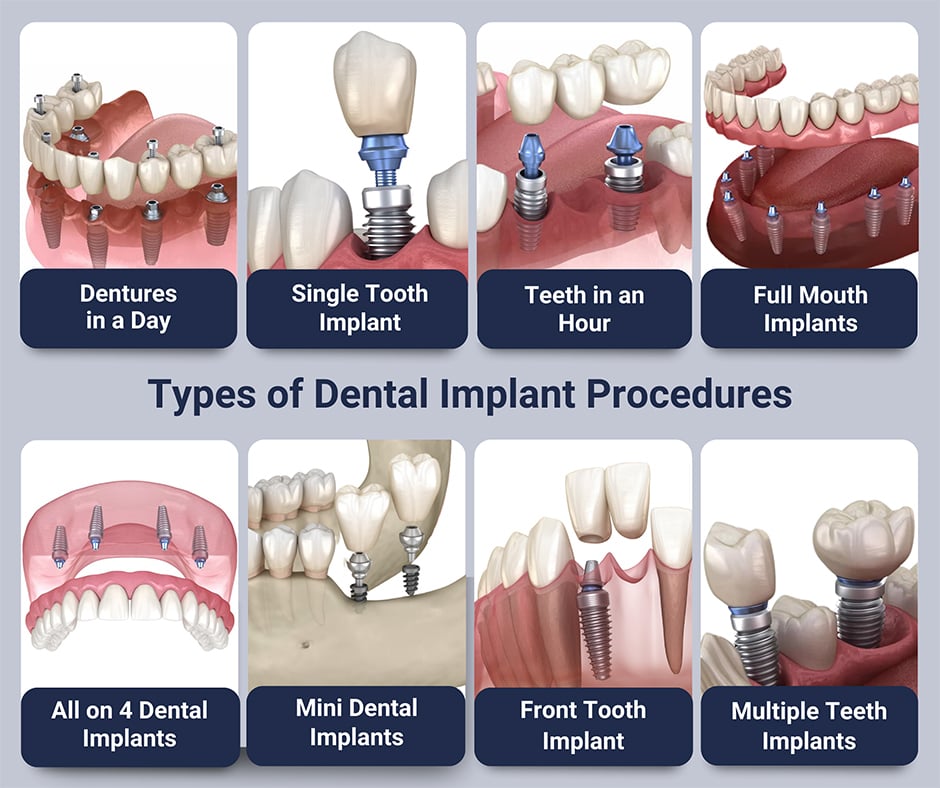Getting The Dental Implants To Work
Getting The Dental Implants To Work
Blog Article
Some Known Incorrect Statements About Dental Implants
Table of ContentsThe smart Trick of Dental Implants That Nobody is DiscussingHow Dental Implants can Save You Time, Stress, and Money.Not known Details About Dental Implants Dental Implants Fundamentals Explained
are medical devices operatively implanted into the jaw to restore an individual's ability to eat or their appearance. They give assistance for artificial (fake) teeth, such as crowns, bridges, or dentures. When a tooth is shed as a result of injury or condition, a person can experience difficulties such as quick bone loss, defective speech, or changes to eating patterns that lead to discomfort.
Framework of The Dental Implant System selecting dental implants, talk to your dental company regarding the possible advantages and dangers, and whether you are a prospect for the treatment. Things to think about: Your general health is an essential consider identifying whether you are a good candidate for oral implants, the length of time it will certainly require to recover, and for how long the dental implant might remain in place.
Cigarette smoking may influence the healing process and reduce the lasting success of the implant. The recovery procedure for the dental implant body may take numerous months or longer, throughout which time you commonly have a short-term joint in place of the tooth. the dental implant treatment: Meticulously comply with the dental hygiene instructions given to you by your dental company.
More About Dental Implants
Implant failure can result in the requirement for an additional surgery to repair or replace the dental implant system. Brings back the capability to chew Restores aesthetic look Aids maintain the jawbone from shrinking because of bone loss Preserves the health of the surrounding bone and periodontals Assists maintain nearby (close-by) teeth steady Improves lifestyle Damage to surrounding all-natural teeth throughout dental implant placement Injury to the surrounding cells during surgical treatment, such as sinus opening Injury during surgical procedure (for instance, crack of bordering jawbone) Insufficient feature, such as feeling like the teeth do not attack together generally A sensation that the tooth is loose or turning in position arising from a joint screw loosening Implant body failure (looseness of the dental implant body) due to systemic infection, which may be much more likely in patients with uncontrolled diabetes mellitus because of regional infection in bone and gum tissues sustaining the dental implant body as a result of postponed recovery, which might be more probable in individuals who smoke Problem cleaning the gum tissues around the implant, resulting in inadequate oral health Unattended periodontal disease Post-surgical pins and needles as a result of nerve impingement or damage Always inform health care suppliers and imaging service technicians that you have dental implants prior to any kind of magnetic resonance imaging (MRI) or x-ray procedures.
FDA is not knowledgeable about any type of adverse events reported for MRI or x-ray treatments with dental implants. Dental implants systems are generally constructed from products that follow international agreement standards of the International Company for Standardization (ISO) or ASTM International. These criteria have details of what makes a secure product.
Other products such as gold alloys, cobalt-based alloys, titanium alloys, or ceramic materials are sometimes made use of. The security profiles of these materials are popular. Oral implant systems are examined according to worldwide consensus requirements. Biocompatibility testing, to show that bodily contact with the gadget does not create complications like irritability or allergic response, belongs to the analysis that helps make sure the products in the oral implant system are secure and do not cause see negative effects when dental implanted in individuals.

How Dental Implants can Save You Time, Stress, and Money.
Some people are not eligible for dental implant surgery. It is for oral specialists to operate on individuals with: intense illnessuncontrollable metabolic diseasebone or soft tissue condition or infectionIf these concerns are solved, an individual can have the surgical treatment. Dental Implants. In, dental specialists refrain from operating on individuals with: If people with any of the above undergo dental implant surgical treatment, there is a greater danger of the dental implant stopping working
Some individuals have a jawbone irregularity that prevents adequate bone for an implant from creating. you could check here The surgeon will after that utilize a bone or bone alternative to repair and develop up the area.
Dental dental implant surgical treatment is a customized procedure. Provide you time to recover. Connect the blog post and last crown, bridge or denture.
Next off, your surgeon will very carefully place the dental implant into your jaw. Ultimately, your specialist will rearrange your gum tissues and close the cut with stitches. If your implant is near the front of your mouth, your dental expert will make a short-term tooth for you to put on till you heal. This way, you won't have a space in your smile while you recuperate.
The Buzz on Dental Implants
Your copyright can tell you what to anticipate in your circumstance. During the recovery stage, your jawbone needs to fuse to the oral implant. This procedure, called osseointegration, is critical for stability and long-term success. This procedure can take anywhere from 3 to 9 months. In many cases, it may take longer.
When your implant my response heals, your dentist can affix the joint (tiny connector message) and your last repair (crown, bridge or denture). This typically takes regarding one hour to finish and might need a 2nd minor surgery. You should not really feel any type of pain during your dental implant procedure since your provider will make use of drug to numb your periodontals.
Report this page